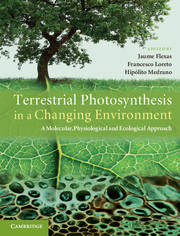 Terrestrial Photosynthesis in a Changing Environment
Terrestrial Photosynthesis in a Changing Environment Published online by Cambridge University Press: 05 March 2013
Introduction
The ‘tropics’ are the most diverse and productive ecosystems on earth. They are broadly defined as those ecosystems that lie between 23.4° N and S latitude. The development of tropical ecosystems as we know them occurred shortly after the rise to dominance of angiosperms and coincided with the diversification of many angiosperm lineages. During this period, between 100 and 36 MA, warm paleoclimates supported much larger areas of tropical vegetation globally. Tropical forests were found not only in equatorial regions but also in mid latitudinal bands north and south of subtropical arid belts (Morley, 2000). Tropical climates are broadly characterised as having more diurnal than seasonal variation in temperatures, but often large seasonal variations in rainfall. Within the tropics, ecosystems range from hot, humid-lowland wet-tropical rain forests to cold, dry high-alpine paramos. Figure 27.1, for example, shows 30-year monthly means for temperature and precipitation for four stations within 1°C of the equator. The Kenyan station had the greatest temperature variations, but even then, the range was only 4°C. Izobamba, Ecuador, at 3050 m elevation, was nearly 15°C cooler than the other sites. Rainfall totals varied eightfold between Garissa, Kenya and Padang, Indonesia, and even within Indonesia precipitation varied by 40% between the sites.
Although tropical plants face similar basic ecophysiological challenges to those in non-tropical ecosystems, the tropics are unique in the sheer diversity of species and life forms and the general lack of freezing temperatures (except in high-mountain ecosystems). In this chapter, we will concentrate our discussion on three major types of tropical environments (wet tropical forests, savannas and mangroves). In each ecosystem, we explore major areas of research related to the ecophysiology of photosynthesis.
To save this book to your Kindle, first ensure [email protected] is added to your Approved Personal Document E-mail List under your Personal Document Settings on the Manage Your Content and Devices page of your Amazon account. Then enter the ‘name’ part of your Kindle email address below. Find out more about saving to your Kindle.
Note you can select to save to either the @free.kindle.com or @kindle.com variations. ‘@free.kindle.com’ emails are free but can only be saved to your device when it is connected to wi-fi. ‘@kindle.com’ emails can be delivered even when you are not connected to wi-fi, but note that service fees apply.
Find out more about the Kindle Personal Document Service.
To save content items to your account, please confirm that you agree to abide by our usage policies. If this is the first time you use this feature, you will be asked to authorise Cambridge Core to connect with your account. Find out more about saving content to Dropbox.
To save content items to your account, please confirm that you agree to abide by our usage policies. If this is the first time you use this feature, you will be asked to authorise Cambridge Core to connect with your account. Find out more about saving content to Google Drive.